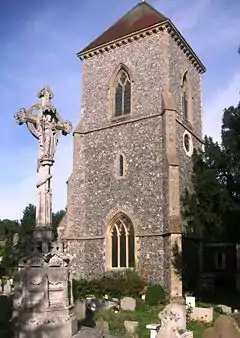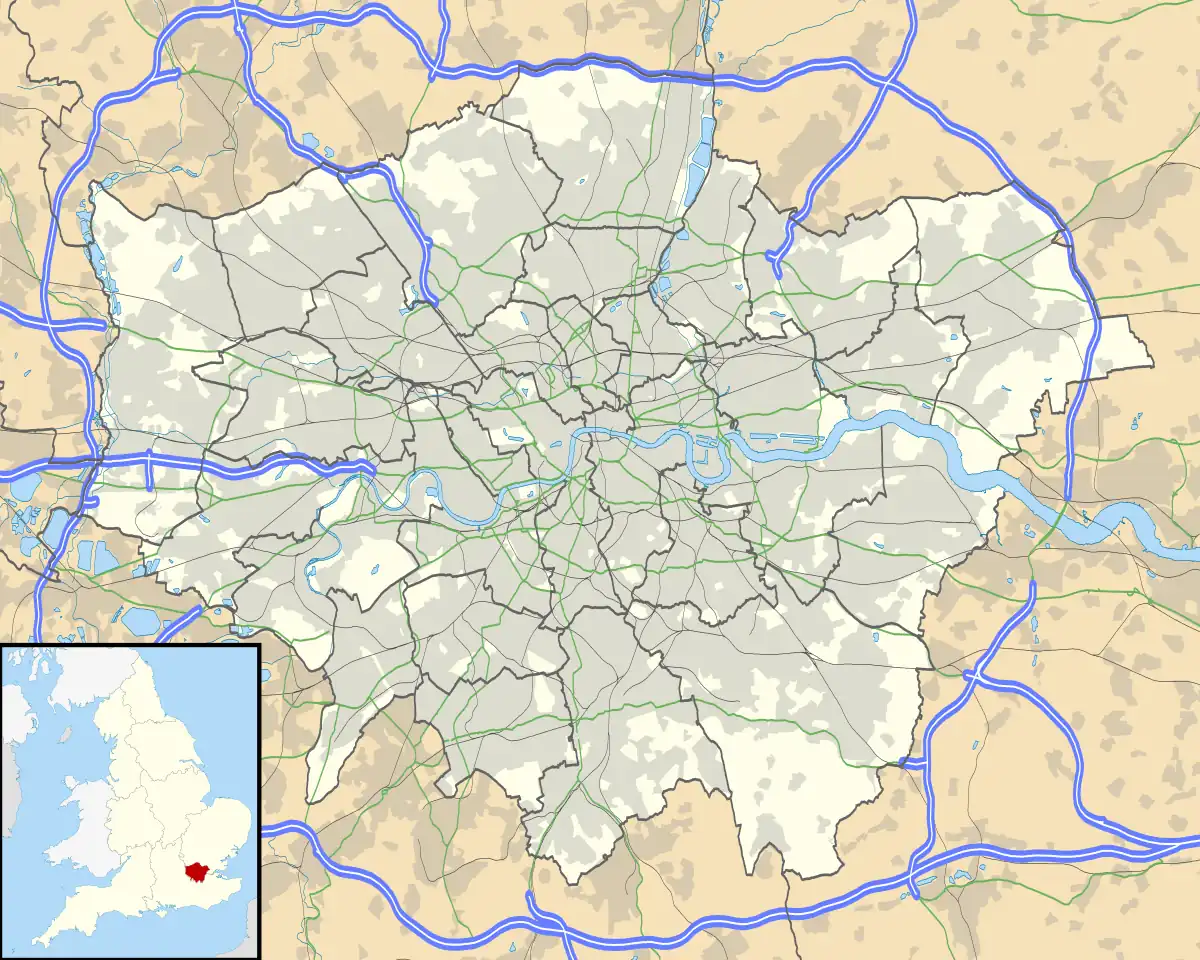Addington, London
Addington is a village and area in south London, England, within the London Borough of Croydon. It is south of Spring Park, west of Coney Hall, north of New Addington and east of Forestdale and Selsdon, and is 11.1 miles (18 km) south of Charing Cross and 4 miles (6.4 km) south-east of the centre of Croydon.
| Addington | |
|---|---|
 | |
 Addington Location within Greater London | |
| OS grid reference | TQ375645 |
| • Charing Cross | 11.1 mi (17.9 km) NNW |
| London borough | |
| Ceremonial county | Greater London |
| Region | |
| Country | England |
| Sovereign state | United Kingdom |
| Post town | CROYDON |
| Postcode district | CR0 |
| Post town | SOUTH CROYDON |
| Postcode district | CR2 |
| Dialling code | 01689[1] |
| Police | Metropolitan |
| Fire | London |
| Ambulance | London |
| UK Parliament | |
| London Assembly | |
History
In Domesday Book of 1086, the area was named Edintona and then Eddintone.[2] The village lay within the Wallington hundred in the county of Surrey. Addington is thought to be named after Edda, a Saxon landowner. In Domesday, two manors are mentioned, linked with the names Godric and Osward.[3]
Addington Palace
Addington Place, later known as Addington Farm and now called Addington Palace, dominates the village above the church of St Mary the Blessed Virgin Church and The Cricketers pub. The manor house was situated behind the church and was the residence of the Leigh family. There is an oft repeated, but false account of a royal hunting lodge, "where King Henry VIII supposedly wooed Anne Boleyn, whose family owned nearby Wickham Court" by West Wickham Parish Church. However, the Anne Boleyn of Wickham Court was the aunt of Queen Anne.
The Palladian Palace was built in 1780 by Barlow Trecothick, from Boston, Massachusetts in the colonial Province of Massachusetts Bay, who returned to England and became an MP and Lord Mayor of the City of London in 1770. After his death without heirs, his nephew James Ivers (later Trecothick), also of Boston, continued his uncle's work and had the grounds laid out by Capability Brown.[4] The estate was sold and eventually, as Croydon Palace became too inconvenient and unsanitary, the Addington house and part of the estate was bought for the Archbishops of Canterbury as a country residence.[4] The last Archbishop to use it was Archbishop Benson. From 1954-1996, Addington Palace was the headquarters of the Royal School of Church Music.[5]
New Addington
Around 1805 parts of the estate covering what is now New Addington were sold to John Cator of Beckenham Place, including Castle Hill Farm. Cator left this to George and Henry Sparkes in his Will in 1806, citing "Addington recently acquired from ..... Trecothick" but the land appears as part of the Cator estates in an 1825 private Act of Parliament allowing the Cators to sell the land, as John Barwell Cator was transferring the main estate holdings to Woodbastwick in Norfolk.[6]

In the 20th century, technological advances and population growth in the region led to many changes in the way of life for people in Addington. At the beginning of the century, Addington was in the county of Surrey, which had established urban and rural districts to provide services matched to the needs of the differing communities. The parish of Addington was transferred to Godstone Rural District on abolition of Croydon Rural District in 1915. Subsequently, Addington parish was absorbed by the County Borough of Croydon in 1925. Since 1965 the county borough has been part of the London Borough of Croydon within highly urbanized Greater London, which ended over 900 years of administration by the county of Surrey.
New Addington was developed to the south of the existing village from the 1930s onwards.
There are still several old houses and buildings in Addington and, even though there has been some fairly modern building, the village atmosphere is intact in the 21st century, despite its being in Greater London. There is a blacksmith's forge, dating from around 1740, now mainly making ornamental ironwork.[8] The hunt used to meet outside the pub, The Cricketers which has reverted to its former name once again after a temporary change of name. The village co-operative store and post office is now a private house.
St Mary the Blessed Virgin Church
.jpg.webp)
St Mary's Church, Addington is an Anglican church in the village. It is associated with the Archbishops of Canterbury of the 19th century, who lived at nearby Addington Palace.[4] Five successive archbishops are buried at the church: Charles Manners-Sutton (d.1828); William Howley (d.1848); John Bird Sumner (d.1862); Charles Longley (d.1868); and Archibald Campbell Tait (d.1882).[9]
Transport
Rail
Addington Village Interchange (also known as Addington Village tram stop) connects the area with Tramlink services to West Croydon and New Addington. Addington Palace is served by Gravel Hill tram stop on the same line.[10]
Bus
The interchange also provides access to bus routes run by Transport for London, which connect it with areas including Bromley, Croydon, Eltham, Hayes, New Addington, Orpington, Purley and Thornton Heath.
Sport
Cricket has been played in the village since at least the 18th century.[4]
The Addington Golf Club is regarded as an important golf facility in the London area.[11]
Gallery
See also
- Addington, New Zealand - a Christchurch suburb, named after Addington Palace, the summer residence of John Sumner.[14]
References
- "Farnborough (Kent) Telephone Code. Farnborough (Kent) Area Code". ukphoneinfo.com.
- http://www.domesdaymap.co.uk/place/TQ3863/addington/ Archived 25 February 2015 at the Wayback Machine Domesday Map Online: Addington
- Lysons, Daniel (1792). The Environs of London. Vol. 1, County of Surrey. London. pp. 1–10. Retrieved 25 February 2015.
- Willey, Russ (2006). The London Gazzetteer. Chambers Harrap Publishers Ltd. pp. 3–4.
- "History of the RSCM". Royal School of Church Music.
- Will of John Cator, 1825 private Act of Parliament.
- Historic England. "Addington Palace (Royal School of Church Music) (Grade II*) (1358819)". National Heritage List for England. Retrieved 7 December 2015.
- "Online communities". 22 January 2016.
- "Church Timeline: 1850 - present day". St Mary's Church, Addingtom. Archived from the original on 24 June 2016. Retrieved 21 May 2016.
- "Croydon Tramlink : Tram Stops : Gravel Hill". The Trams. Retrieved 16 July 2019.
- Oliver, Darius (September 2016). Planet golf. Thames & Hudson Australia Pty, Limited. ISBN 978-0-500-50081-1. OCLC 950264993.
- "The Addington Forge". Retrieved 2 September 2020.
- Historic England. "Flint Cottage, Addington (1079345)". National Heritage List for England. Retrieved 2 September 2020.
- Reed, A. W. (2010). Peter Dowling (ed.). Place Names of New Zealand. Rosedale, North Shore: Raupo. p. 17. ISBN 978-0-14-320410-7.
External links
- Addington in the Domesday Book
Further reading
- Addington: A History by Frank Warren, (Phillimore & Company; 1984)


.jpg.webp)



